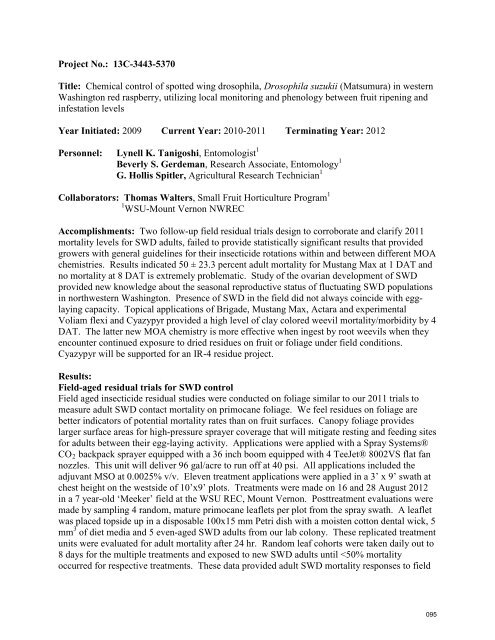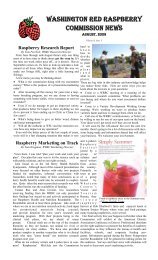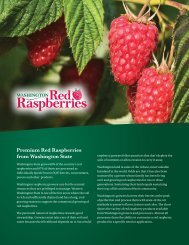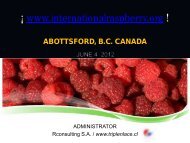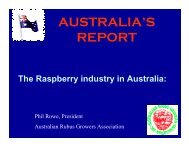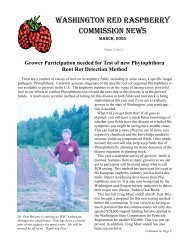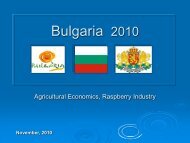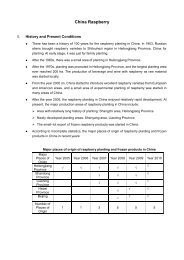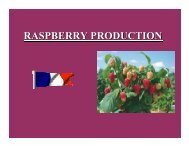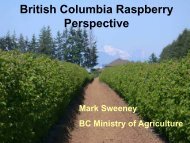2012 - Washington Red Raspberry Commission
2012 - Washington Red Raspberry Commission
2012 - Washington Red Raspberry Commission
Create successful ePaper yourself
Turn your PDF publications into a flip-book with our unique Google optimized e-Paper software.
Project No.: 13C-3443-5370<br />
Title: Chemical control of spotted wing drosophila, Drosophila suzukii (Matsumura) in western<br />
<strong>Washington</strong> red raspberry, utilizing local monitoring and phenology between fruit ripening and<br />
infestation levels<br />
Year Initiated: 2009 Current Year: 2010-2011 Terminating Year: <strong>2012</strong><br />
Personnel: Lynell K. Tanigoshi, Entomologist 1<br />
Beverly S. Gerdeman, Research Associate, Entomology 1<br />
G. Hollis Spitler, Agricultural Research Technician 1<br />
Collaborators: Thomas Walters, Small Fruit Horticulture Program 1<br />
1 WSU-Mount Vernon NWREC<br />
Accomplishments: Two follow-up field residual trials design to corroborate and clarify 2011<br />
mortality levels for SWD adults, failed to provide statistically significant results that provided<br />
growers with general guidelines for their insecticide rotations within and between different MOA<br />
chemistries. Results indicated 50 ± 23.3 percent adult mortality for Mustang Max at 1 DAT and<br />
no mortality at 8 DAT is extremely problematic. Study of the ovarian development of SWD<br />
provided new knowledge about the seasonal reproductive status of fluctuating SWD populations<br />
in northwestern <strong>Washington</strong>. Presence of SWD in the field did not always coincide with egglaying<br />
capacity. Topical applications of Brigade, Mustang Max, Actara and experimental<br />
Voliam flexi and Cyazypyr provided a high level of clay colored weevil mortality/morbidity by 4<br />
DAT. The latter new MOA chemistry is more effective when ingest by root weevils when they<br />
encounter continued exposure to dried residues on fruit or foliage under field conditions.<br />
Cyazypyr will be supported for an IR-4 residue project.<br />
Results:<br />
Field-aged residual trials for SWD control<br />
Field aged insecticide residual studies were conducted on foliage similar to our 2011 trials to<br />
measure adult SWD contact mortality on primocane foliage. We feel residues on foliage are<br />
better indicators of potential mortality rates than on fruit surfaces. Canopy foliage provides<br />
larger surface areas for high-pressure sprayer coverage that will mitigate resting and feeding sites<br />
for adults between their egg-laying activity. Applications were applied with a Spray Systems®<br />
CO 2 backpack sprayer equipped with a 36 inch boom equipped with 4 TeeJet® 8002VS flat fan<br />
nozzles. This unit will deliver 96 gal/acre to run off at 40 psi. All applications included the<br />
adjuvant MSO at 0.0025% v/v. Eleven treatment applications were applied in a 3’ x 9’ swath at<br />
chest height on the westside of 10’x9’ plots. Treatments were made on 16 and 28 August <strong>2012</strong><br />
in a 7 year-old ‘Meeker’ field at the WSU REC, Mount Vernon. Posttreatment evaluations were<br />
made by sampling 4 random, mature primocane leaflets per plot from the spray swath. A leaflet<br />
was placed topside up in a disposable 100x15 mm Petri dish with a moisten cotton dental wick, 5<br />
mm 3 of diet media and 5 even-aged SWD adults from our lab colony. These replicated treatment<br />
units were evaluated for adult mortality after 24 hr. Random leaf cohorts were taken daily out to<br />
8 days for the multiple treatments and exposed to new SWD adults until


